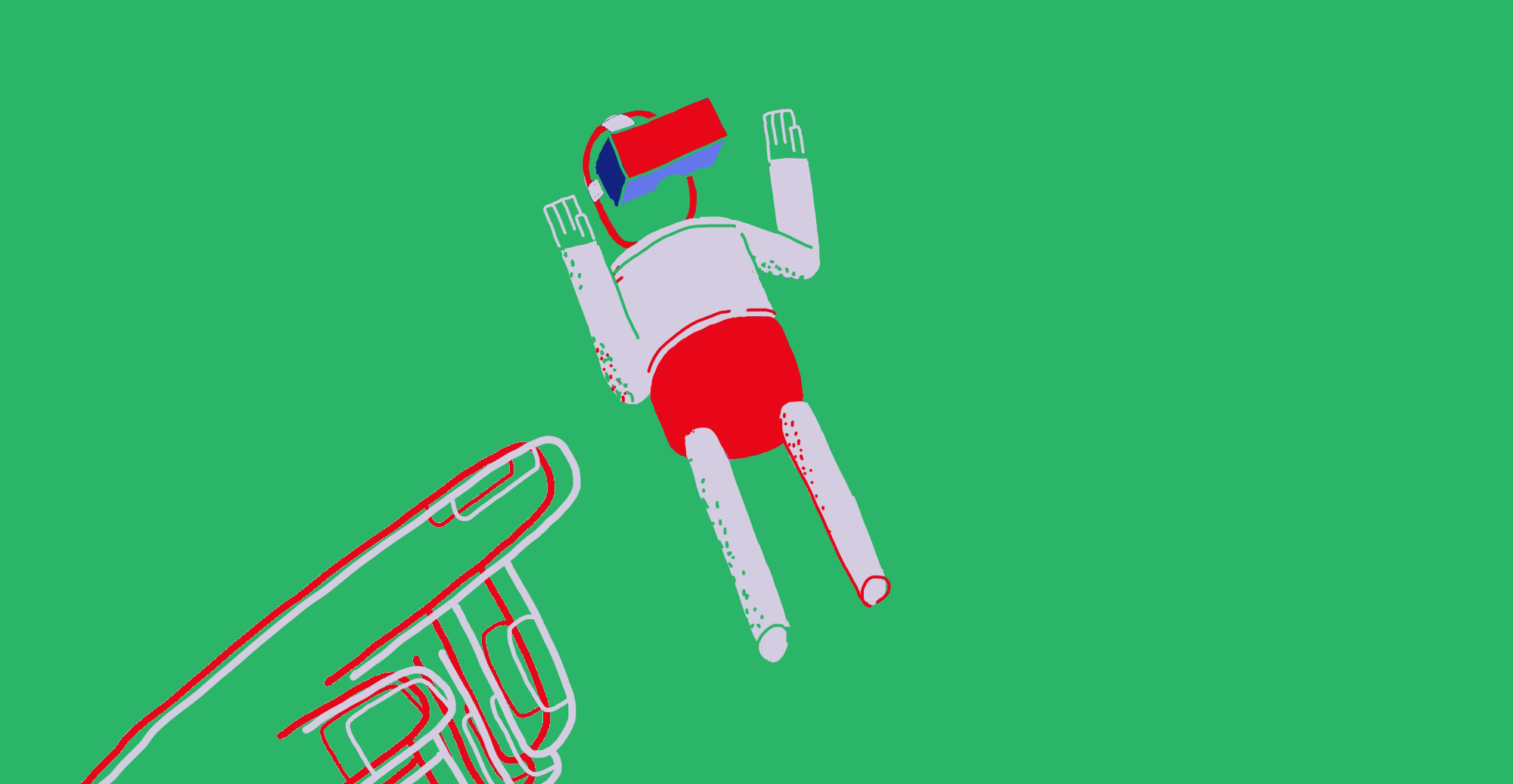The War on the Disturbingly Real Trolls in Virtual Reality

I felt awkward when Katie Kelly, a slim woman in a turquoise sweater, stepped closer. Despite the crackling campfire, this was a professional meeting, and she had intruded on my personal space. “Around here it starts to feel a little bit too uncomfortable,” said Kelly, looking up at the white humanoid robot that was my own body.
Kelly was gently demonstrating why she and others at social virtual-reality startup AltSpaceVR have been working on ways to give people more control of their virtual personal space. Industry leaders such as Facebook’s Mark Zuckerberg say that virtual reality must become a place we can socialize if the medium is to become widely popular. But the feeling of “presence” that can make virtual reality so compelling also makes awkward or hostile interactions with other people much more jarring.
In the latest evolution of online trolling, some visitors to AltSpace and other virtual social spaces where you can mingle with strangers exploit that, for example by touching people’s virtual bodies without permission. “The whole thing with presence is that it basically is the same as if it’s happening in the real world,” says Philip Rosedale, founder and CEO of social VR company High Fidelity (see “The Quest to Put More Reality in Virtual Reality”). Kelly and others in the industry say that the effects of such behavior tend to be disproportionately borne by women. “You have people getting close to you and wanting to touch your body because you appear as a woman, it’s really unpleasant,” says Jodi Schiller, founder and CEO of New Reality Arts, which helps companies build VR experiences for marketing purposes. “This is the next computing platform and it’s really important it includes women.”
Experiences like that were one reason that Kelly and coworkers at AltSpaceVR formed an all-female team last year to design a feature called the “personal space bubble.” It causes other people’s avatars to disappear and become inaudible if they get closer than about an arm’s length of your own virtual body, and makes you invisible and inaudible to them. The bubble is active by default, but you can turn it off if you do want to get closer to someone (Kelly says that air kissing is an important greeting between friends in AltSpace).
AltSpace also lets you mute specific avatars to prevent you from hearing each other, or to block them, making you and them mutually invisible. The company also has a human “concierge” available 24/7 to field reports of unsavory activity.
High Fidelity launched its own version of the personal space bubble early this year, and has its own mute and block features. Rosedale says the company saw a slight uptick in bad behavior toward others after the company’s software became available on the video-game app store Steam in November, leading to an influx of new users. As well as offering public virtual spaces, AltSpace and High Fidelity both let users create private places to mingle with others, but since so few people own VR hardware, for most people, socializing by necessity involves meeting strangers.
He and Kelly both say that VR trolls are in the vast minority, and argue that they will become less of a problem as more people become used to the technology and the culture of virtual-reality spaces becomes more established. “VR has created a different space and so [users] are figuring out what the rules of that space are,” says Kelly.
Rosedale says that improvements to VR hardware and the activities on offer in virtual worlds will also help people be more friendly. “When you get into a lot of these VR environments, there's nothing that you can change or do other than yell at people,” he says. “If you give people a lot of creative freedom, then people get along better.”
Raph Koster, a high-profile video-game designer whose hits include the multiplayer online game Star Wars Galaxies, thinks VR trolling is in fact likely to get worse. He used a keynote at the gaming industry’s giant GDC conference in San Francisco earlier this month to warn that VR companies need to do more than offer victims defensive tools such as space bubbles and mute features. He says companies will have to start more actively curating, investigating, and punishing bad user behavior, for example by hiring dedicated staff.
“If anything, the behavior now is better than it will ever be,” says Koster of the current moment in social VR. He says his experience launching Ultima Online, one of the first virtual environments that could host thousands of people at once, showed that when more people start visiting a virtual space, trolling becomes more of a problem because they feel more anonymous. “When you get strangers bumping up against one another they behave more poorly,” he says. “Peer pressure is one of the things that keeps people behaving well.”
Keep Reading
Most Popular
Large language models can do jaw-dropping things. But nobody knows exactly why.
And that's a problem. Figuring it out is one of the biggest scientific puzzles of our time and a crucial step towards controlling more powerful future models.
How scientists traced a mysterious covid case back to six toilets
When wastewater surveillance turns into a hunt for a single infected individual, the ethics get tricky.
The problem with plug-in hybrids? Their drivers.
Plug-in hybrids are often sold as a transition to EVs, but new data from Europe shows we’re still underestimating the emissions they produce.
Stay connected
Get the latest updates from
MIT Technology Review
Discover special offers, top stories, upcoming events, and more.